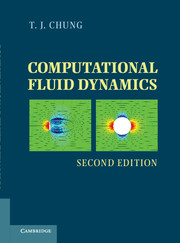Book contents
- Frontmatter
- Contents
- Preface to the First Edition
- Preface to the Revised Second Edition
- Part One Preliminaries
- Part Two Finite Difference Methods
- Part Three Finite Element Methods
- Part Four Automatic Grid Generation, Adaptive Methods, and Computing Techniques
- Part Five Applications
- Chapter Twenty-One Applications to Turbulence
- Chapter Twenty-Two Applications to Chemically Reactive Flows and Combustion
- Chapter Twenty-Three Applications to Acoustics
- Chapter Twenty-Four Applications to Combined Mode Radiative Heat Transfer
- Chapter Twenty-Five Applications to Multiphase Flows
- Chapter Twenty-Six Applications to Electromagnetic Flows
- Chapter Twenty-Seven Applications to Relativistic Astrophysical Flows
- Appendixes
- Index
- References
Chapter Twenty-Seven - Applications to Relativistic Astrophysical Flows
from Part Five - Applications
Published online by Cambridge University Press: 05 June 2012
- Frontmatter
- Contents
- Preface to the First Edition
- Preface to the Revised Second Edition
- Part One Preliminaries
- Part Two Finite Difference Methods
- Part Three Finite Element Methods
- Part Four Automatic Grid Generation, Adaptive Methods, and Computing Techniques
- Part Five Applications
- Chapter Twenty-One Applications to Turbulence
- Chapter Twenty-Two Applications to Chemically Reactive Flows and Combustion
- Chapter Twenty-Three Applications to Acoustics
- Chapter Twenty-Four Applications to Combined Mode Radiative Heat Transfer
- Chapter Twenty-Five Applications to Multiphase Flows
- Chapter Twenty-Six Applications to Electromagnetic Flows
- Chapter Twenty-Seven Applications to Relativistic Astrophysical Flows
- Appendixes
- Index
- References
Summary
General
Relativistic theory is divided into two categories: special relativity and general relativity. In special relativity, we follow Einstein’s postulate establishing the universality of the speed of light, c, relative to any unaccelerated observer, regardless of the motion of the light’s source from the observer. General relativity arises as an extension to special relativity to describe the motion of particles evolving under the presence of gravitational fields. In order to take into account the effect of gravitation, however, we must abandon the Eulerian coordinates used in Newtonian fluid dynamics. Instead, it is necessary to invoke a curvilinear four-dimensional manifold (the spacetime) to represent particle’s trajectories.
Many of the problems encountered in astrophysics are involved in the numerical solution of special or general relativistic fluid dynamics equations. Active research in this subject area has been in progress for the past 40 years. Earlier studies include structure and evolution of stars [Chandrasekhar, 1942; Aller and McLaughlin, 1965, among others]. Black hole accretion flows have been studied extensively as evident from numerous publications [Paczynski and Wiita, 1980; Katz, 1980; Eggum et al., 1988; Hawley et al., 1984a,b; Clarke et al., 1985; Stella and Vietri, 1997; Bromley et al., 1998; Font et al., 1998a,b; Koide et al., 1999; Font et al., 1999]. Some of the recent activities include Gamma ray bursts [Meszaros and Rees, 1993; Sari and Piran, 1998; Fishman and Meegan, 1995; and Panattescu and Meszros, 1998], explosive and jet phenomena [Norman, 1997], and astrophysical turbulence flows and instability [Bulbus and Hawley, 1998].
- Type
- Chapter
- Information
- Computational Fluid Dynamics , pp. 965 - 986Publisher: Cambridge University PressPrint publication year: 2010



